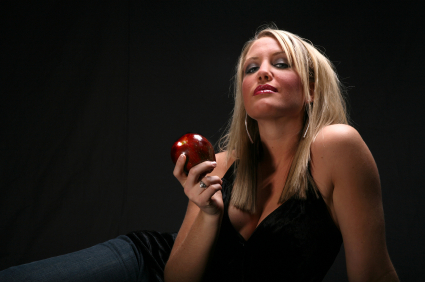The Neuroscience of Temptation

If you are human, you are subject to temptation. In a religious context, temptation is an invitation to sin, i.e., to break the established rules of that particular faith. Even without the influence of religion, society has both formal constraints (laws) and less formal ones (socially acceptable behavior) that seek to rein in temptation. So, most of us don’t eat food off the shelf in the supermarket even if we are hungry, nor do we grab members of the opposite sex whom we happen to find attractive. Those who don’t control every impulse end up either incarcerated or at least avoided. Some philosophers might say this exercise of self control is what separates humans from other species.
The philosophers may be right, at least in part. A new article in Discover describes the war in our brain when we are presented with temptation:
The most enjoyable sins engage the brain’s reward circuitry, including evolutionarily ancient regions such as the nucleus accumbens and hypothalamus; located deep in the brain, they provide us such fundamental feelings as pain, pleasure, reward, and punishment. More disagreeable forms of sin such as wrath and envy enlist the dorsal anterior cingulate cortex (dACC). This area, buried in the front of the brain, is often called the brain’s “conflict detector,” coming online when you are confronted with contradictory information, or even simply when you feel pain. The more social sins (pride, envy, lust, wrath) recruit the medial prefrontal cortex (mPFC), brain terrain just behind the forehead, which helps shape the awareness of self.
No understanding of temptation is complete without considering restraint, and neuroscience has begun to illuminate this process as well. As we struggle to resist, inhibitory cognitive control networks involving the front of the brain activate to squelch the impulse by tempering its appeal. Meanwhile, research suggests that regions such as the caudate—partly responsible for body movement and coordination—suppress the physical impulse. It seems to be the same whether you feel a spark of lechery, a surge of jealousy, or the sudden desire to pop somebody in the mouth: The two sides battle it out, the devilish reward system versus the angelic brain regions that hold us in check. [From I Didn’t Sin—It Was My Brain by Kathleen McGowan.]
The so-called “angelic” regions are the areas of the brain that are more developed in humans.
Lust in the Brain
 We’ve all heard jokes that suggest men don’t think with their head when presented with sexually arousing stimuli. Actually, nothing could be further from the truth – the problem is, their whole brain lights up:
We’ve all heard jokes that suggest men don’t think with their head when presented with sexually arousing stimuli. Actually, nothing could be further from the truth – the problem is, their whole brain lights up:
When it comes to lust, neuroimaging confirms that the prurient urge is all-encompassing. Watching pornography calls upon brain regions associated with reward, sensory interpretation, and visual processing. It enlists the amygdala and the hypothalamus, which deal with emotional information; it also stimulates the reward-processing ventral striatum, probably due to the satisfying nature of watching erotic stimuli. All said, the most notable thing about lust is that it sets nearly the whole brain buzzing…
Marketers undestand this well, and use sexual images to sell just about anything. One of my most popular all-time Neuromarketing articles is Bikinis, Babes, and Buying, which describes research showing that men make different, and often worse, decisions when they are aroused.
More Temptations
McGowan’s article goes on to describe gluttony, sloth, pride, greed, envy, and wrath – all from a neuroscience perspective. This is a fascinating article, and I highly recommend it for both marketers and anyone else who wants to understand how we make decisions when our brains are conflicted.
Altruism Still Wins
The article finishes on a positive note. Despite the overwhelming impact of tempting stimuli on our brains, helping others can be just as powerful:
Jordan Grafman recently found that virtue literally is its own reward. Altruistic behavior sends reward-related brain systems into a pleasurable tizzy—even more so than the prospect of self-interested gain. “The big punch line is that all things being equal, your reward system fires off a lot more when you’re giving than when you’re taking,” says Grafman, who is chief of the cognitive neuroscience section at the National Institute of Neurological Disorders and Stroke. Call it the dirty little secret about being good: It might be even more fun than being wicked. [Emphasis added.]
